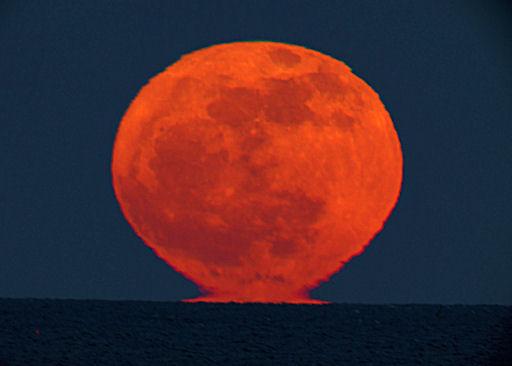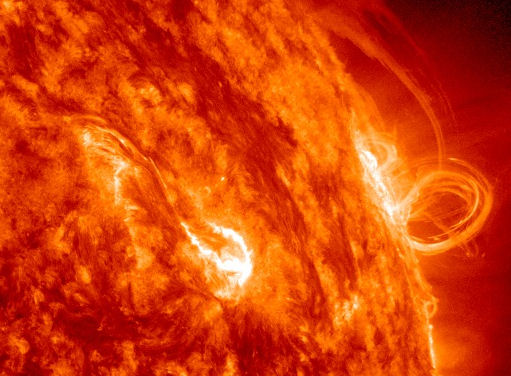SOLAR WIND: A medium-velocity (450-500 km/s) solar wind stream is blowing past Earth and sparking auroras around the Arctic Circle. NOAA forecasters estimate a 30% chance of polar geomagnetic storms during the next 24 hours. Aurora alerts: text, voice.
MELTING SNOW MOON: According to folklore, last night's full Moon was the "Snow Moon." John Stetson watched it melt, apparently, as it rose through a layer of relatively warm air over the waters of Cape Elizabeth, Maine:
It's a mirage, caused by sun-warmed air overlying the sea surface. The temperature profile turned Earth's atmosphere into a lens, refracting the rays of the rising Moon and distorting the lunar disk as shown. Jules Verne noticed the same kind of distortion in sunrises and sunsets, and famously likened them to an Etruscan Vase.
That's not all: "A green rim can be seen along the top of the moon," points out Stetson. "And there is a red fringe along the bottom." This is also caused by the prismatic action of the low atmosphere.
more Snow Moonshots: from Chris Allington of Little Sioux, Iowa; from Jeremy Bennetts of Leavenworth, Kansas; from Evan Ludes of Little Sioux, IA; from Robert T. Smith of Stoneville, NC; from Jack Dembicky of Sunspot, NM
PARTING SHOTS: In the past 48 hours, formerly-quiet sunspot AR1410 has turned into a dynamo of activity, rumbling with long-duration solar flares and significantly boosting the sun's extreme ultraviolet output. NASA's Solar Dynamics Observatory photographed glowing arcs of magnetism over the active region during the early hours of Feb. 8th:
The affect of this activity on Earth is minimal because the sunspot is rotating over the sun's northwestern limb. For the next two weeks, the departing 'spot will transit the farside of the sun under the watchful gaze of NASA's twin STEREO probes. The planet most likely to be hit by an eruption during that time is Mercury. Stay tuned for reports from STEREO. Solar flare alerts: text, voice.
![]()

![]()
Solar wind
speed: 477.4 km/sec
density: 0.1 protons/cm3
explanation | more data
Updated: Today at 1353 UT
![]()
X-ray Solar Flares
6-hr max: B6 1258 UT Feb08
24-hr: C2 0000 UT Feb08
explanation | more data
Updated: Today at: 1400 UT
![]()
![]()
![]()
Daily Sun: 08 Feb 12
![]()
![]()
Departing sunspot AR1410 is crackling with C- and M-class solar flares. A new sunspot is emerging at the circld location. Credit: SDO/HMI
![]()
![]()
![]()
Sunspot number: 24
What is the sunspot number?
Updated 06 Feb 2012
Spotless Days
Current Stretch: 0 days
2012 total: 0 days (0%)
2011 total: 2 days (<1%)
2010 total: 51 days (14%)
2009 total: 260 days (71%)
Since 2004: 821 days
Typical Solar Min: 486 days
Updated 06 Feb 2012
The Radio Sun
10.7 cm flux: 112 sfu
explanation | more data
Updated 06 Feb 2012
![]()
![]()
![]()
Current Auroral Oval:
Switch to: Europe, USA, New Zealand, Antarctica
Credit: NOAA/POES
![]()
![]()
![]()
Planetary K-index
Now: Kp= 2 quiet
24-hr max: Kp= 4 unsettled
explanation | more data
![]()
Interplanetary Mag. Field
Btotal: 3.5 nT
Bz: 1.8 nT south
explanation | more data
Updated: Today at 1356 UT
![]()
![]()
![]()
Coronal Holes: 08 Feb 12
![]()
![]()
Solar wind flowing from this coronal hole should reach Earth on Feb. 10-11. Credit: SDO/AIA.






